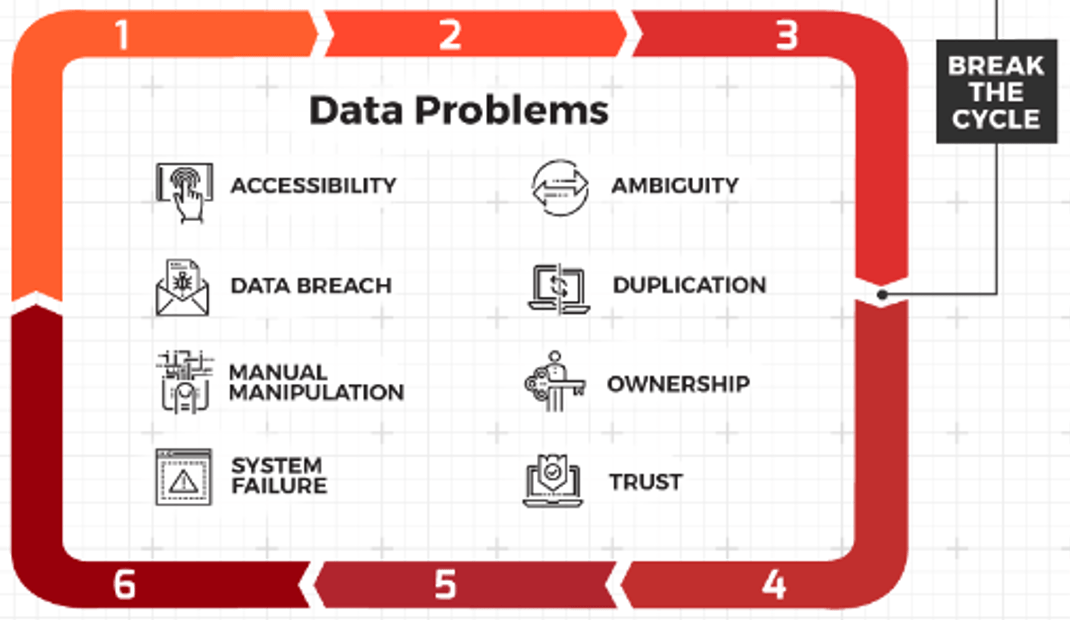Build Your Data Practice and Platform

The complex nature of data investment leads to de-scoping and delivery of data services that do not meet business needs or give value to the business. Subject matter experts are hired to resolve the problem, but their success is impacted by absent architecture, technology, and organizational alignment.
Our Advice
Critical Insight
Walking through a book of architecture building plans with a personal guide is cheaper and faster than employing an architect to build and design your home.
Impact and Result
Info-Tech's approach provides a proven methodology that includes the following:
- Business-aligned data initiatives and capabilities that address data challenges and realize business strategic objectives.
- Comprehensive data practice designed based on the required business and data capabilities.
- Data platform design based on Info-Tech data architecture reference patterns and prioritized data initiatives and capabilities.
Build Your Data Practice and Platform Research & Tools
Besides the small introduction, subscribers and consulting clients within this management domain have access to:
1. Build Your Data Practice and Platform Storyboard – A step-by-step document that leverages road-tested patterns and frameworks to properly build your data practice and pattern in continuous alignment with the business landscape.
Info-Tech's approach provides a proven methodology that includes following:
- Build Your Data Practice and Platform Storyboard
2. Data Practice and Platform Models – Leveraging best-of-breed frameworks to help you build a clear, concise, and compelling data practice and platform.
Data practice & platform pre-build pattern templates based on Info-Tech data reference patterns and data platform design best practices.
- Data Practice and Platform Models
Infographic
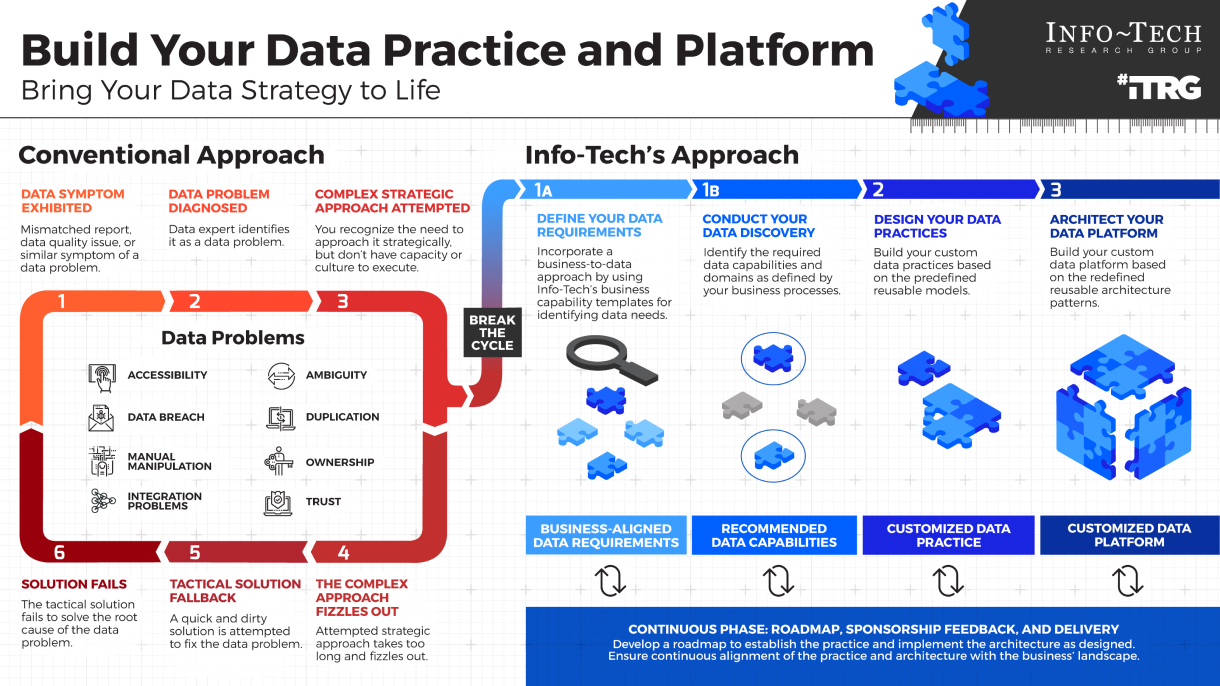
Workshop: Build Your Data Practice and Platform
Workshops offer an easy way to accelerate your project. If you are unable to do the project yourself, and a Guided Implementation isn't enough, we offer low-cost delivery of our project workshops. We take you through every phase of your project and ensure that you have a roadmap in place to complete your project successfully.
1 Establish Business Context and Value
The Purpose
Establish business context and value.
Key Benefits Achieved
Business context and strategic driver.
Activities
1.1 Understand/confirm the organization's strategic goals
1.2 Classify the strategic goals and map to business drivers
1.3 Identify the business capabilities that the strategy focuses on
1.4 Identify the business processes realizing the strategy
Outputs
Business context and strategic drivers
Prioritized business capabilities and processes
Data culture survey results analysis
2 Identify Your Top Initiatives
The Purpose
Identify your top initiatives.
Key Benefits Achieved
High-value business-aligned data initiative.
Activities
2.1 Highlight data-related outcomes/goals to realize to fulfill the business goal
2.2 Map business data initiatives to the business strategic goals
2.3 Prioritize data initiatives
Outputs
High-value, business-aligned data initiatives
3 Analyze Data Challenges
The Purpose
Analyze data challenges.
Key Benefits Achieved
Clear understanding of the data challenges.
Activities
3.1 Map data challenges to Info-Tech data challenges
3.2 Review Info-Tech data capabilities based on prioritized initiatives
3.3 Discuss data platform and practice next steps
Outputs
List of data challenges preventing data maturation with the organization
4 Map Data Capability
The Purpose
Map data capability.
Key Benefits Achieved
Prioritized data capability.
Activities
4.1 Map data challenges to Info-Tech data challenges
4.2 Review Info-Tech data capabilities based on prioritized initiatives
4.3 Discuss data platform and practice next steps
Outputs
Required data capabilities
Data platform and practice – plan
Initialized data management RACI
Further reading
Build Your Data Practice and Platform
Construct a scalable data foundation
Analyst Perspective
Build a data practice and platform that delivers value to your organization.
The build or optimization of your data practice and data platform must be predicated on a thorough understanding of the organization’s goals, objectives, and priorities and the business capabilities and process they are meant to support and enable.
Formalizing your practice or constructing your platform just for the sake of doing so often results in an initiative that is lengthy, costly, fizzles out, does not deliver business value, and ends up being considered a failure.
Leverage Info-Tech’s approach and incorporate our pre-built models and patterns to effectively navigate that crucial and often difficult phase upfront of comprehensively defining business data needs so you can ultimately realize faster time-to-delivery of your overall data practice and platform.
 |
Rajesh Parab
|
 |
Crystal Singh
|
Attempting to Solve Data Problems?
Situation
|
Complication
|
Resolution
|
Info-Tech Insight
The true value of data comes from defining intentional relationships between the business and the data through a well thought out data platform and practice.
Situation – Perpetual Data Problem
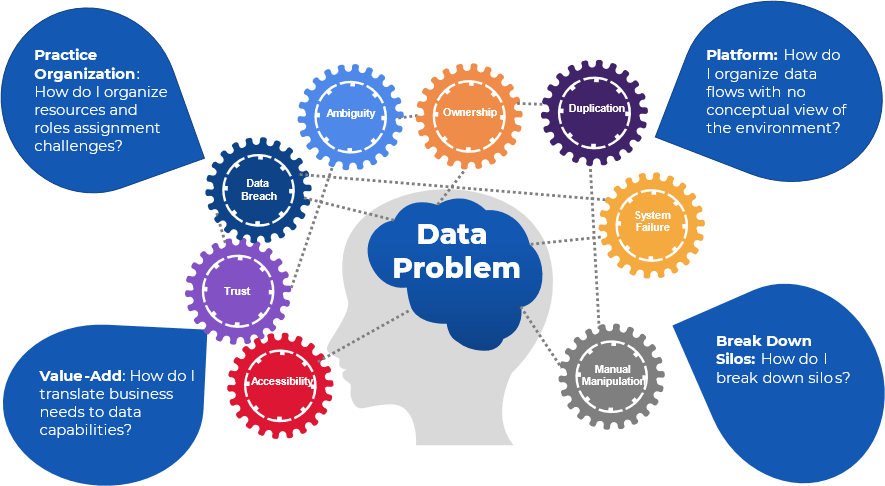
I can’t access the data. I don’t trust the data in the report. It takes too long to get to the data for decision making |
|
Complication – Data Initiative Fizzles Out
|
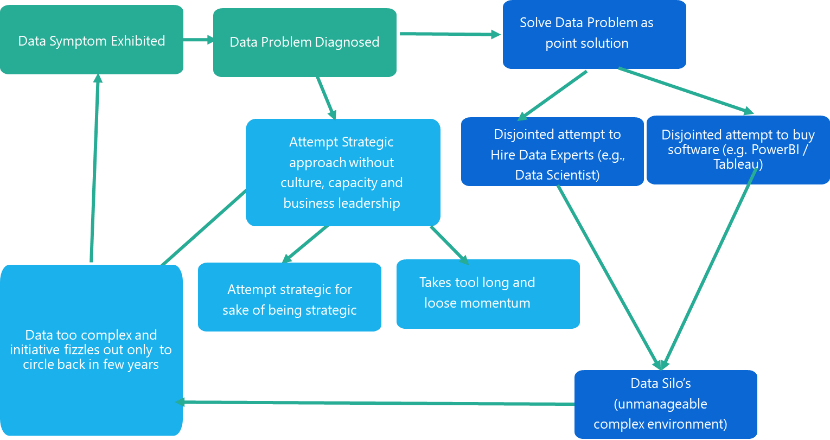
Use the road-tested patterns and frameworks in our blueprint to break the perpetual data solution cycle. Focus on the value that a data and analytics platform will bring rather than focusing on the data problems alone. |
Build Your Data Practice and PlatformBring Your Data Strategy to Life |

 |
CONVENTIONAL WISDOM
Attempting to Solve Your Data Problems
|
BREAK THE CYCLE
Solving Your Data Problems
|
CONTINUOUS PHASE: ROADMAP, SPONSORSHIP FEEDBACK AND DELIVERY
Develop a roadmap to establish the practice and implement the architecture as designed. Ensure continuous alignment of the practice and architecture with the business landscape. |
|||||||||
Phase-by-Phase Approach to Build Your Data Practice and Platform
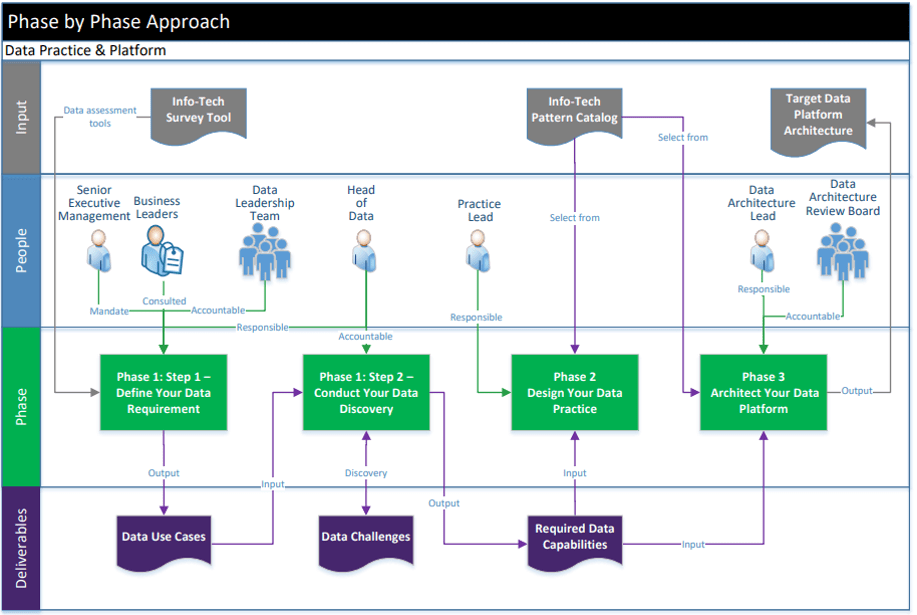 |
Phase-by-Phase Approach
|
Measure value when building your data practice and platform
Sample Data Management Metrics
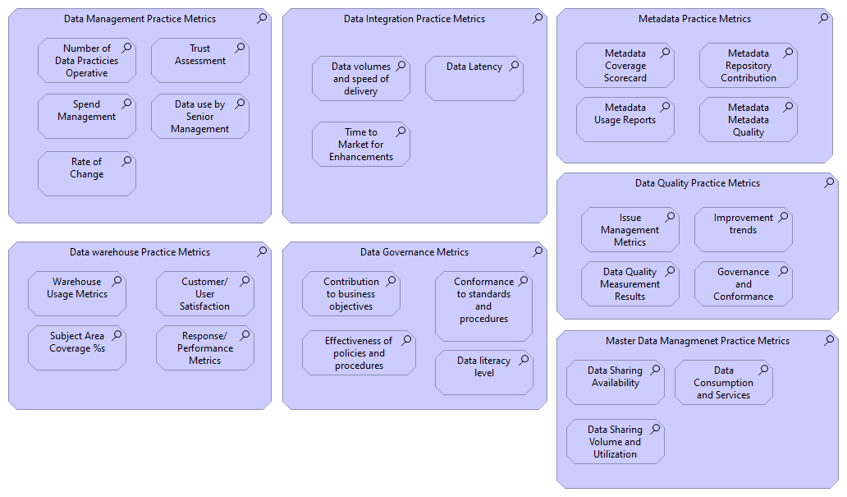
- Refine the metrics for the overall Data Management practice and every initiative therein.
- Refine the metrics at each platform and practice component to show business value against implementation effort.
Understand and Build Data Culture
See your Info-Tech Account Representative for more details on our Data Culture Diagnostic
| Only 14.29% of Transportation and Logistics respondents agree BI and Analytics Process and Technology are sufficient | What is a diagnostic?
Our diagnostics are the simplest way to collect the data you need, turn it into actionable insights, and communicate with stakeholders across the organization. |
52.54% of respondents from the healthcare industry are unaware of their organization’s data security policy | ||
| Ask the Right Questions
Use our low-effort surveys to get the data you need from stakeholders across the organization. |
Use Our Diagnostic Engine
Our diagnostic engine does all the heavy lifting and analysis, turning your data into usable information. |
Communicate & Take Action
Wow your executives with the incredible insights you've uncovered. Then, get to action: make IT better. |
||
| On average only 40% agree that they have the reporting when needed
(Source: Info-Tech’s Data Culture Diagnostic, 53 Organizations, 3138 Responses) |
35% of respondents feel that a governance body is in place looking at strategic data
Build a Data-Driven Strategy Using Info-Tech Diagnostic ProgramsMake informed IT decisions by starting your diagnostic program today. Your account manager is waiting to help you. |
 |
||
Use Our Predefined Data and Analytics Patterns to Build Your DnA Landscape
Walking through a book of architecture building plans with a personal guide is cheaper and faster than employing an architect to build and design your home
 |
 |
The first step is to align business strategy with data strategy and then start building your data practice and data platform |
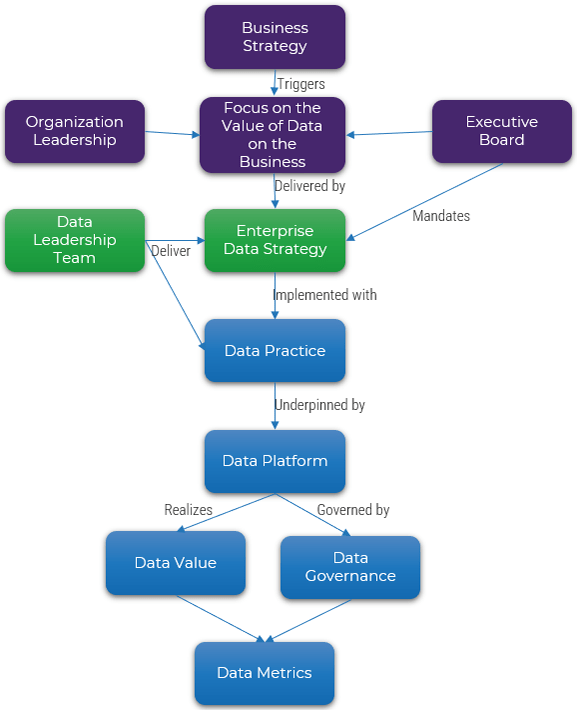 |
Insights
The true value of data comes from defining intentional relationships between the business and the data through a well-thought-out data platform and practice.
- Phase 1
- Some organizations are low maturity so using the traditional Capability Maturity Model Integration (CMMI) would not make sense. A great alternative is to leverage existing models and methodologies to get going off the bat.
- The Data Strategy is an input into the platform and practice. This is considered the Why; Data Practice and Platform is the How.
- Phase 2
- Info-Tech’s approach is business-goal driven and it leverages patterns, which enable the implementation of critical and foundational components and subsequently facilitates the evolution and development of the practice over time.
- Systems should not be designed in isolation. Cross-functional collaboration throughout the design is critical to ensure all types of issues are revealed early. Otherwise, crucial tests are omitted, deployments fail, and end-users are dissatisfied.
- Phase 3
- Build your conceptual data architecture based on well-thought-out formulated patterns that align with your organization’s needs and environment.
- Functional needs often take precedence over quality architecture. Quality must be baked into design, execution, and decision-making practices to ensure the right trade-offs are made.
Info-Tech offers various levels of support to best suit your needs
DIY Toolkit |
Guided Implementation |
Workshop |
Consulting |
| "Our team has already made this critical project a priority, and we have the time and capability, but some guidance along the way would be helpful." | "Our team knows that we need to fix a process, but we need assistance to determine where to focus. Some check-ins along the way would help keep us on track." | "We need to hit the ground running and get this project kicked off immediately. Our team has the ability to take this over once we get a framework and strategy in place." | "Our team does not have the time or the knowledge to take this project on. We need assistance through the entirety of this project." |
Diagnostics and consistent frameworks used throughout all four options |
|||
Info-Tech’s Methodology for Building Your Data Practice and Platform
| Phase 1 –
Define Your Data Requirements and Conduct Your Data Discovery |
Phase 2 –
Design Your Data Practices |
Phase 3 –
Architect Your Data Platform |
|
| Phase Steps |
|
|
|
| Phase Outcomes | Business-aligned data initiatives and capabilities that address data challenges and realize business strategic objectives | Comprehensive data practice design based on the required business and data capabilities | Data platform design based on Info-Tech data architecture reference pattern and prioritized data initiatives and capabilities |
Data Platform and Practice Implementation Plan
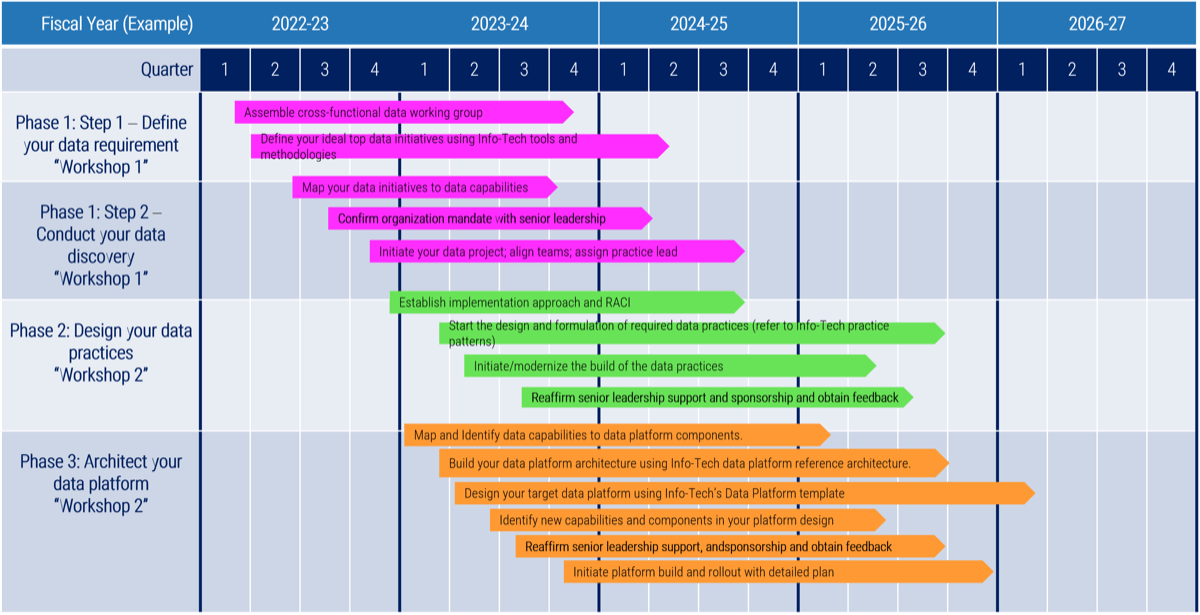
Workshop Overview |
Contact your account representative for more information.
|
| Info-Tech’s Workshop support for Build Your Data Practice and Platform. | 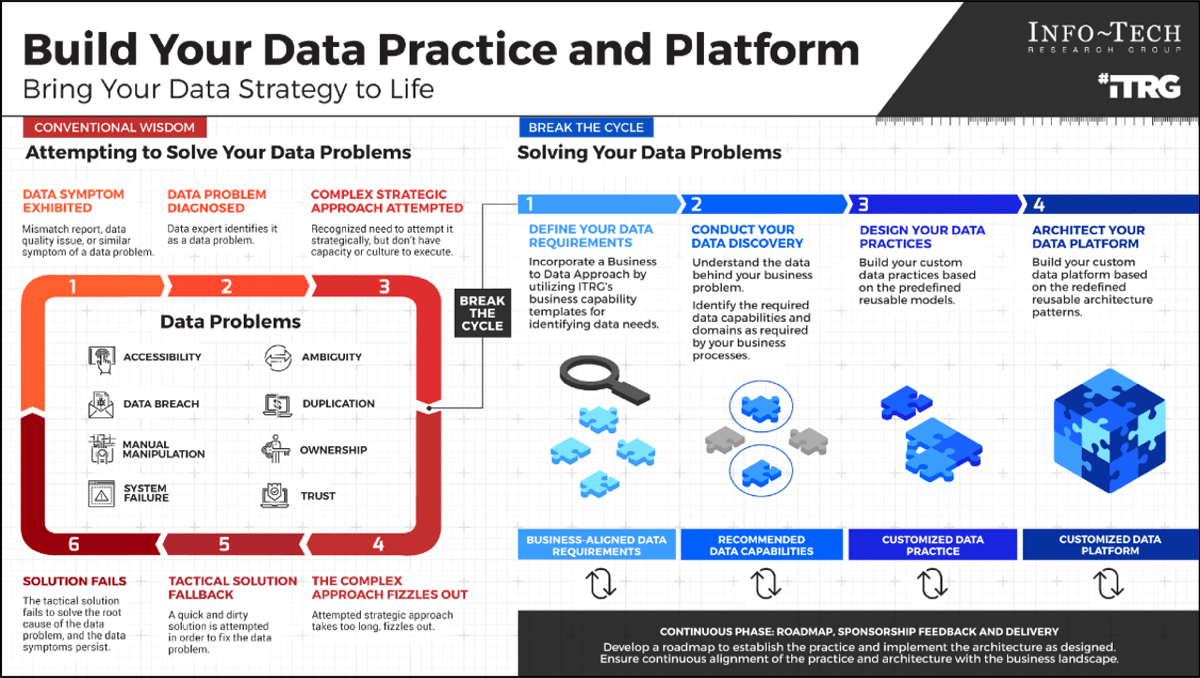 |
||
| Workshop
"We need to hit the ground running and get this project kicked off immediately. Our team has the ability to take this over once we get a framework and strategy in place." |
Workshop 1 | Workshop 2 | Workshop 3 |
Workshop 1: | Contact your account representative for more information.
|
| Day 1 | Day 2 | Day 3 | Day 4 | |
Establish Business Context and Value |
Identify Your Top Initiatives |
Analyze Data Challenges |
Map Data Capability |
|
| Activities | 1.1 Understand/confirm your organization’s strategic goals 1.2 Classify the strategic goals and map to business drivers 1.3 Identify the business capabilities that the strategy focus is on 1.4 Identify the business processes realizing the strategy |
2.1 Highlight data-related outcomes /goals to realize to fulfill the business goal 2.2 Map business data initiatives to the business strategic goals 2.3 Prioritize Data initiatives |
3.1 Understand data management capabilities and framework 3.2 Classify business data requirements using Info-Tech’s classification approach 3.3 Highlight data challenges in your current environment |
4.1 Map data challenges to Info-Tech data challenges 4.2 Review Info-Tech data capabilities based on prioritized initiative 4.3 Discuss Data Platform and Practice Next Steps |
| Deliverables |
|
|
|
|
| Participants | Business stakeholder, Business leader Business Subject Matter Expert, Data IT sponsor (CIO), Head of Data, Data Architect | Business stakeholder, Business leader Business Subject Matter Expert, Data IT sponsor (CIO), Head of Data, Data Architect | Data experts, Business Subject Matter Expert, Head of Data, Data Architect | Data experts, Business Subject Matter Expert, Head of Data, Data Architect |
Workshop 2: | Contact your account representative for more information.
|
| Day 1 | Day 2 | Day 3 | Day 4 | |
Plan Your Data Practices |
Design Your Data Practices 1 |
Design Your Data Practices 2 |
Design Your Data Practices 3 |
|
| Activities | Prerequisite: Business context, business data requirement, and data capabilities 1.1 Understand data practice framework 1.2 Define your practice implementation approach 1.3 Review and update data management RACI |
2.1 Understand Info-Tech data practice patterns for each prioritized practice 2.2 Define your practice setup for each prioritized practice 2.3 Highlight critical processes for each practice |
3.1 Understand Info-Tech data practice patterns for each prioritized practice 3.2 Define your practice setup for each prioritized practice 3.3 Highlight critical processes for each practice |
4.1 Understand Info-Tech data practice patterns for each prioritized practice 4.2 Define your practice setup for each prioritized practice 4.3 Highlight critical processes for each practice 4.4 Discuss data platform and practice next steps |
| Deliverables |
|
|
|
|
| Participants | Data experts, Business Subject Matter Expert, Head of Data, Data Architect | Data experts, Business Subject Matter Expert, Head of Data, Data Architect | Data experts, Business Subject Matter Expert, Head of Data, Data Architect | Data experts, Business Subject Matter Expert, Head of Data, Data Architect |
Workshop 3: | Contact your account representative for more information.
|
| Day 1 | Day 2 | Day 3 | Day 4 | |
Data Platform Overview | Update Data Platform Reference Architecture | Design Your Data Platform | Design Your Data Practices 4 | |
| Activities | Prerequisite: Business context, business data requirement, and data capabilities 1.1 Understand data platform framework and data capabilities 1.2 Understand key data architecture principles and best practices 1.3 Shortlist data platform patterns | 2.1 Map and identify data capabilities to data platform components 2.2 Build data platform architecture using Info-Tech data platform reference architecture 2.3 Highlight critical processes for each practice | 3.1 Design your target data platform using Info-Tech’s data platform template 3.2 Identify new capabilities and components in your platform design | 4.1 Identify new capabilities and component in your platform design 4.2 Discuss data platform initiatives |
| Deliverables |
|
|
|
|
| Participants | Data experts, Business Subject Matter Expert, Head of Data, Data Architect | Data experts, Business Subject Matter Expert, Head of Data, Data Architect | Data experts, Business Subject Matter Expert, Head of Data, Data Architect | Data experts, Business Subject Matter Expert, Head of Data, Data Architect |
Build Your Data Practice and Platform
Phase 1
Phase 1: Step 1 – Define Your Data Requirements
Phase 1: Step 2 – Conduct Your Data Discovery
| Phase 1
1.1 Define Your Data Requirements
|
Phase 2 | Phase 3 |
Phase 1: Step 1 – Define Your Data Requirements will walk you through the following activities:
- Confirm the organizational strategic goals, business drivers, business capabilities, and processes driving the Data Practice and Platform effort.
- Identify the data related outcomes, goals, and ideal environment needed to fulfill the business goals.
This phase involves the following participants:
A blend of business leaders and business SMEs together with the Data Strategy team.
Phase 1: Step 2 – Conduct Your Data Discovery will walk you through the following activities:
- Identify and highlight the data challenges faced in achieving the desired outcome.
- Map the data challenges to the data capabilities required to realize the desired data outcome.
This phase involves the following participants:
Key personnel from IT/Data team: (Data Architect, Data Engineers, Head of Head of Reporting and Analytics)
Buying Options
Build Your Data Practice and Platform
IT Risk Management · IT Leadership & Strategy implementation · Operational Management · Service Delivery · Organizational Management · Process Improvements · ITIL, CORM, Agile · Cost Control · Business Process Analysis · Technology Development · Project Implementation · International Coordination · In & Outsourcing · Customer Care · Multilingual: Dutch, English, French, German, Japanese · Entrepreneur
Tymans Group is a brand by Gert Taeymans BV
Gert Taeymans bv
Europe: Koning Albertstraat 136, 2070 Burcht, Belgium — VAT No: BE0685.974.694 — phone: +32 (0) 468.142.754
USA: 4023 KENNETT PIKE, SUITE 751, GREENVILLE, DE 19807 — Phone: 1-917-473-8669
Copyright 2017-2022 Gert Taeymans BV
